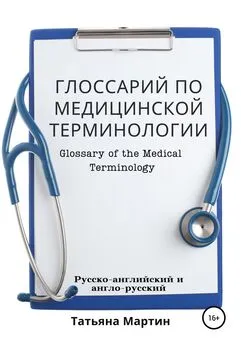Татьяна Мартин - Глоссарий по медицинской терминологии. Glossary of the Medical Terminology
- Название:Глоссарий по медицинской терминологии. Glossary of the Medical Terminology
- Автор:
- Жанр:
- Издательство:неизвестно
- Год:2021
- ISBN:нет данных
- Рейтинг:
- Избранное:Добавить в избранное
-
Отзывы:
-
Ваша оценка:
Татьяна Мартин - Глоссарий по медицинской терминологии. Glossary of the Medical Terminology краткое содержание
Глоссарий по медицинской терминологии. Glossary of the Medical Terminology - читать онлайн бесплатно ознакомительный отрывок
Интервал:
Закладка:
Cerebrum is the process of control memory, sensations, emotions, voluntary movements, consciousness, and higher mental activity.
Кора больших полушарий головного мозга или кора головного мозга (лат. cortexcerebri) – структура головного мозга, слой серого вещества толщиной 1,3–4,5 мм, расположенный по периферии полушарий большого мозга и покрывающий их.
The cerebral cortex and surface of the cerebrum, the outermost layer of the brain, made up primarily of grey matter. There are four lobes in the cortex, the frontal lobe, parietal lobe, temporal lobe, occipital lobe.
Между полушариями проходит продольная щель большого мозга, ограниченная краями полушарий и мозолистым телом.
Longitudinal fissure divides cerebrum on two hemispheres: right and left.
Извилина (лат. gyrus, множ. gyri) – выступы (складки), лежащие между бороздами (углублениями) на поверхности полушарий конечного мозга. Борозды и извилины создают характерную «морщинистую» поверхность полушарий головного мозга человека.
The gyri (gyrus) is the ridge on the surface of the brain; surrounded by fissures known as sulci. Gyri have an evolutionary function; they increase the surface area of the brain.
Борозда (лат. sulcus, множ. sulci) – углубления (желобки) на поверхности полушарий конечного мозга. Небольшие борозды окружают извилины (складки), более крупные и глубокие борозды разделяют доли и полушария.
The sulci (sulcus) is a groove in the cerebral cortex, surrounds a gyrus. The larger sulci are usually called fissures.
Промежуточный мозг располагается между средним и передним мозгом. Основными образованиями промежуточного мозга являются таламус (зрительный бугор) и гипоталамус. Последний соединен с гипофизом – главной железой внутренней секреции.
Diencephalon locates between the cerebrum and midbrain. It consists of several structures: the thalamus, hypothalamus, and pineal gland.
Средний мозг – располагается между подкоркой и задним участком мозга, находится в самом центре органа. Представляет собой связующий сегмент между верхними и нижними структурами, так как через него проходят нервные мозговые тракты.
Midbrain is the topmost part of the brainstem, the connections between the brain and the spinal cord.
В состав заднего мозга входят продолговатый мозг, мозжечок и варолиев мост.
Posterior includes the bridge and cerebellum.
Мозжечок учувствует в поддержании мышечного тонуса, координации движения и равновесия.
Cerebellum maintaining muscle tone, coordinating normal movement and balance.
Ствол мозга соединяет головной мозг со спинным. Проходит через все три отдела мозга
The brain stem is a region between the diencephalon and the spinal cord. It consists of the midbrain, pons, and medulla obligate.
Продолговатый мозг (medullaoblongata) является продолжением спинного мозга. В продолговатом мозге находятся нервные центры многих рефлексов: дыхания, сердечно-сосудистый, потоотделения, пищеварения, сосания, моргания, мышечного тонуса.
The medulla oblongata is a continuation of the spinal cord within the skull, forming the lowest part of the brainstem and containing control centers for the heart and lungs.
Мост является частью ствола мозга. Через мост проходят все восходящие и нисходящие пути, связывающие передний мозг со спинным мозгом, с мозжечком и другими структурами ствола.
The bridge (pons) contains nuclei that relay signals from the forebrain to the cerebellum, along with nuclei that deal primarily with sleep, respiration, swallowing, bladder control, hearing, equilibrium, taste, and others.
Ретикулярная система – это пункт контроля обратной связи. Получает и передает электрические импульсы от всех нервных клеток.
Reticular formation set of interconnected nuclei that are located throughout the brainstem; includes neurons located in different parts of the brain. The reticular formation includes ascending pathways to the cortex in the ascending reticular activating system (ARAS) and descending pathways to the spinal cord via the reticulospinal tracts.
Мозолистое тело – это толстый пучок нервных волокон. Полушарии головного мозга взаимодействуют друг с другом через мозолистое тело.
The Corpus callosum is a wide, thick nerve tract, consisting of a flat bundle of commissural fibers beneath the cerebral cortex in the brain. It spans part of the longitudinal fissure, connecting the left and right cerebral hemispheres, enabling communication between them. It is the largest white matter structure in the human brain.
Базальное ядро – это серое вещество в центре полушарий. Контрольная система, координирующая мышечную бессознательную деятельность.
Basal ganglia are a group of subcortical nuclei situated at the base of the forebrain and top of the midbrain. Basal ganglia are strongly interconnected with the cerebral cortex, thalamus, brainstem, and several other brain areas. The basal ganglia are associated with a variety of functions, including control of voluntary motor movements, procedural learning, habit learning, eye movements, cognition, and emotion.
Таламус выполняет роль коммутатора между спинным мозгом и полушариями головного мозга.
The thalamus is a small structure within the brain located just above the brain stem between the cerebral cortex and the midbrain and has extensive nerve connections to both. The main function of the thalamus is to relay motor and sensory signals to the cerebral cortex.
Эпифиз – это эндокринная железа неврогенной группы, представлена небольшим шишковидным телом серовато-красноватого цвета, располагающимся в области четверохолмия среднего мозга.
The pineal body, also called conarium, epiphysis cerebri, pineal gland, or pineal body, is the source of melatonin, a hormone derived from tryptophan that plays a central role in the regulation of circadian rhythm (the roughly 24-hour cycle of biological activities associated with natural periods of light and darkness).
В коре головного мозга можно выделить четыре доли: затылочную, теменную, височную и лобную.
Each side of your brain contains four lobes.
Височные доли участвует в образовании долговременной памяти, также обрабатывает визуальную и слуховую информацию, способствует пониманию языка.
The temporal lobe is involved in the formation of long-term memory, also processes visual and auditory information, and contributes to understanding language.
Теменные доли отвечают за интеграцию сенсорной информации, в том числе обеспечивает взаимосвязь между тактильными ощущениями и болью.
The parietal lobe gathers sensory information, mainly relating to touch, taste, and temperature.
Затылочные доли отвечают главным образом за зрение.
The occipital lobe is primarily responsible for vision.
Лобные доли отвечают за движение, речь, сложное мышление человека.
The frontal lobe is important for cognitive functions and control of voluntary movement or activity.
Спинной мозг – это столб нервной ткани, 40 см, внутри позвоночника. Двусторонняя проводящая система между головным мозгом и периферической нервной системой
The spinal cord is a long, fragile tubelike structure that begins at the end of the brain stem and continues down almost to the bottom of the spine. The spinal cord consists of nerves that carry incoming and outgoing messages between the brain and the rest of the body.
5.1. Патологические состояния нервной системы. Pathological Condition of the nervous system
Болезнь Альцгеймера (также сенильная деменция альцгеймеровского типа) – наиболее распространённая форма деменции, нейродегенеративное заболевание. Заболевание вызывает медленное повреждение нейронов и отмирание тканей мозга.
Alzheimer's disease is an irreversible, progressive brain disorder that slowly destroys memory, thinking skills, and physical functioning. In most people with the disease symptoms first appear in their mid-60s.
Боковой амиотрофический склероз (ALS) – нейродегенеративное заболевание, поражающее двигательные нейроны в головном и спинном мозге.
Amyotrophic lateral sclerosis (ALS) is a progressive nervous system disease that affects nerve cells in the brain and spinal cord, causing loss of muscle control.
Абсцесс головного мозга – очаговое скопление гноя в веществе головного мозга. Заболевание вызывают стафилококки, стрептококки, грибы, кишечные палочки, анаэробные бактерии.
A brain abscess is a collection of pus enclosed in the brain tissue, caused by a bacterial or fungal infection. A brain abscess can develop as a complication of an infection, trauma, or surgery.
Читать дальшеИнтервал:
Закладка:









